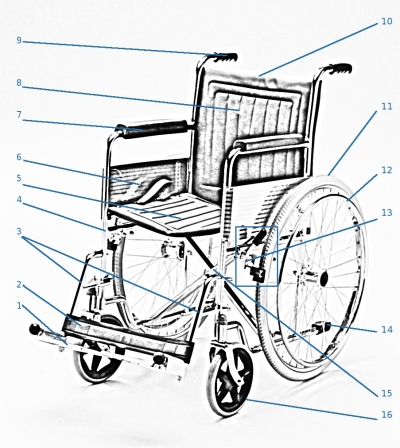The Wheelchair Guide
Your Wheelchair and Mobility Scooter Resource
Manual Wheelchair Parts Diagram
Monday, April 20th, 2009
Today, there are a number of different wheelchairs available, but the most common is the steel framed wheelchair. This type of manual wheelchair shares the E & J design, which was developed over eighty years ago, and is the type found in most hospitals. They are also referred to as Traditional wheelchairs, standard wheelchairs, or Conventional Wheelchairs.
Below, you will find a diagram of a traditional wheelchair and a list of its components. Click on any of the links to find out its description or you can scroll down the page.

- Footrest
- Legrest
- Front Rigging
- Frame
- Seat
- Metal Skirt
- Armrests
- Backrest
- Push Handles
- Push Axle
- Rear Wheels
- Handrims
- Brakes
- Tipping Lever
- Crossbars
- Caster Wheels
- Anti-Tip Casters (Not Pictured)
1. Footrest: The footrests, which are also called footplates and footpedals, can be adjusted to accommodate different lengths and can also be rotated.
2. Legrest: The legrest extends from the front of the wheelchair and the footrest is attached to the legrest.
3. Front Rigging: The front rigging refers to the footrest arm and the legrest as a single unit. In most conventional wheelchairs, the front rigging can be removed, but this is not always the case in less expensive models. It can also often be elevated to provide an elevated leg rest.
4. Frame: The conventional wheelchairs frame is made out of cold rolled steel that is chrome plated. The frame is the heaviest part of the wheelchair and it can weigh up to 50 pounds, but a stainless steel frame is also available that weighs about ten pounds less.
5. Seat: The seat, like the other fabric parts of a conventional wheelchair, is made from vinyl and uses a sling design. Multiple colors are often available and the vinyl fabric makes it very easy to clean.
6. Metal Skirt: The metal skirt is installed on either side of a conventional wheelchair between the armrests. It is designed to protect the users clothes from dirt, moisture, and debris that can be kicked up by the wheels. Metal Skirts also prevent the users clothes from becoming caught in the wheelchair.
7. Armrests: There are two types of armrests: Full length and Desk Type. The armrests are secured to the frame in two places and are designed to be very sturdy.
8. Backrest: The Backrest height is fixed and typically is about 16 ½ inches high. However, reclining backrests and extending backrest are available as options for most conventional wheelchairs.
9. Push handles: The Push Handles are located on the back of the wheelchair and rubber handles are installed to make them more comfortable.
10. Push Axle: The Push Axle ensures provides support for the push handles and is at a fixed height.
11. Rear Wheels: Typically the rear wheels will be 24 inches in diameter. Both Pneumatic and Solid tires are used. The rear wheels are used for manual propulsion of the wheelchair.
12. Handrims: The handrims extend outwards from the rear wheel. They are typically chrome plated and are used to propel the wheelchair.
13. Brakes: The brakes are located on the large rear wheels. They are typically located on the front of the wheel next to the bottom of the seat.
14. Tipping Lever: The tipping lever extends from the bottom of the frame and is designed to make it easier to move the wheelchair over obstacles, such as curbs. The person pushing the wheelchair will put weight on the tipping lever, which causes the wheelchair to tip backwards.
15. Crossbars: The crossbars are located under the seat and allow the wheelchair to be easily folded for storage and transportation. There are typically no locks to keep the conventional wheelchair from folding, but instead the weight of the user prevents the wheelchair from being folded.
16. Caster Wheels: The wheels of a conventional wheelchair are called caster wheels and are typically 8 inches in diameter. They are typically made of solid rubber, but for outdoor use pneumatic tires are recommended.
17. Anti-Tip Casters (Not Pictured): Anti-Tip Casters are not always present on conventional wheelchairs, but they can usually be added. They are designed to prevent the wheelchair from tipping over backwards. In the event that the wheelchair tips over too far, the anti-tip casters make contact with the ground, preventing it from completely tipping over.
The conventional wheelchair remains one of the most popular and recognized type of manual wheelchairs available. They are often available in a number of different colors and many offer features to make them easier to use, such as removable armrests to make transferring into and out of the wheelchair easier. They can be seen in public areas, like hotels, airports, grocery stores, and hospitals, which offer wheelchairs for their patrons to use.